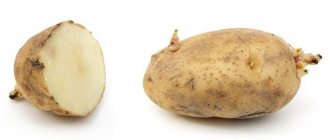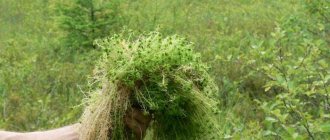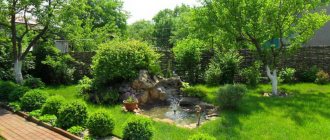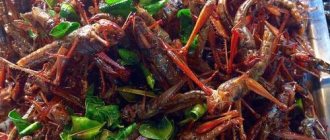Opened lumbago
Lumbago open, best known as sleep-grass. It is distributed throughout Europe, Asia, North America and Canada. This herb is known not only for its medicinal properties. Dream grass has long been used in magic as a talisman against the evil eye and to attract wealth. In ancient times, artists obtained green paint from this plant. But sleep-herb is most widely used in folk medicine.
This plant is poisonous. If exposed externally, burns may occur, and if ingested, it may cause damage to mucous membranes. Also contraindicated for use during pregnancy, gastritis, and ulcers. Official medicine does not use sleep herb for medicinal purposes.
Sleep herb has an antimicrobial and sedative effect. It is often used as a pain reliever, for sleep disorders and nervous system disorders. Externally, herbal decoctions are used to treat fungal skin infections.
Ginseng
Ginseng is a very popular plant. Distributed in China, the Far East, and Korea. It grows more often in forests sheltered from the sun's rays.
The chemical composition of ginseng is very diverse, so the range of its healing properties is very wide. Among them, there is an analgesic effect, as well as a tonic effect. Ginseng improves the performance of the entire body, helps improve gas exchange in the lungs, and also helps with the excretion of bile.
Ginseng root is also used for diseases of the endocrine system, as well as to reduce blood sugar and blood pressure. The use of ginseng is also very beneficial for the nervous system. It is also used to improve the functioning of the reproductive system in men.
Ginseng helps prolong life. It slows down the aging of organs and also strengthens the immune system. In addition, ginseng improves brain function and is also used for wound healing.
The healing properties of ginseng are recognized by official medicine. Therefore, there are many drugs that contain this unique plant.
However, it also has contraindications. This is the period of pregnancy, children under 12 years of age, epilepsy and increased nervous excitability.
Belladonna
Belladonna is a rare poisonous plant. Distributed to a greater extent in the mountains of the Caucasus, Crimea, and Carpathians. All parts of this plant are poisonous. However, some birds can feed on belladonna berries, while consumption by humans can be fatal.
However, this plant is still used in medicine. It has anti-inflammatory and analgesic effects and is also used in the treatment of Parkinson's disease. Widely used in ophthalmology, however, high eye pressure is a contraindication for use. The juice of the plant helps remove age spots on the skin.
Using this plant on your own is very dangerous. All medications containing belladonna should only be taken under medical supervision.
Rare wild plants
Moscow. November 19 (Saturday) 2011 opening of the 11th season of Moscow Commonwealth meetings. Lectures: 1. Vladimir Lyapchev (Togliatti) “Basic techniques for shaping and cutting conifers in central Russia.. 2. Evgeny Tarasov “Shoes (Cypripedium) of East Asia. Life in nature and keeping in the garden."
Starts at 14.00. Novinsky Blvd., 22 (metro station Barrikadnaya). 250 rub.
- All entries
- Community Posts
- Search
Mikhail Belyaev pinned post
Friends! We distribute seeds of rare tree species!
Sequoia, Cedar, Thuja. Lavender and Laurel!
Take care of the environment, grow seeds from the Sannikov Land peasant farm!
Scheherazade Akhmetova's post is pinned
Olga Mironova post pinned
Mikhail Belyaev pinned post
The seed season has begun in Crimea! From us you can order seeds of Sequoia, Lavender, Lebanese Cedar, Atlas Cedar, Himalayan Cedar, Stankevich Pine, Sage, Lavender, Juniper, Chinese Wisteria and many more different seeds!
We ship via SDEK throughout Russia. Prices and details – in PM.
Nastya Marakanova post pinned
Olga Mironova post pinned
Artbeautytravel Artbeautytravel post pinned
Yuri Bazhenov pinned post
"Bazhenov and Plants for an Exquisite Garden"
Unexpectedly, imperceptibly, but these formulations are already ten years old. A lot has happened over the years: we lost something, found something, our own small nursery quietly appeared, and the time has come to think about retail sales, improving sales of our own products and changing the structure of work in general. Show in full…
Finally, the “Company” is expanding from a tandem of me and my wife into a real company - there are more of us.
The basis of the offered assortment is made up of herbaceous perennial plants. This is the mentality of our gardeners and this is the most popular group of garden plants. The geography of purchases of imported material ranges from Ireland to Japan; there are few domestic suppliers. 98% of the material we grow ourselves is also herbaceous perennials. Of course, we try to find and offer interesting tree crops (coniferous, deciduous shrubs and trees), bulbous ones.
Traditionally, we pay the greatest attention to new, non-traditional and rare crops. But we also bring and grow old, proven, reliable cultivars that form the basis of the garden.
The main reason for the disappearance of many species of flora in Russia is human economic activity. Uncontrolled gathering, plowing of land, forest fires and deteriorating environmental conditions in the country are destroying nature. It is not surprising that the Red Book includes hundreds of plant species. It is worth noting that some are included in the list due to their small numbers; they are quite picky about natural conditions and do not grow everywhere. Below is a selection of ten species of rare plants listed in the Red Book of Russia, with a brief description and photo.
Araucaria mirabilis - 160 million years ago (Argentina)
Petrified trunk and pine cones
In 1919, a botanist named Anselmo Windhausen discovered that the inhabitants of Argentine Patagonia collected some kind of fossils, attributing miraculous properties to them. The scientist became interested in fossil remains and in 1923 he discovered the petrified forest of Cerro Cuadrado. The age of this formation was 160,000,000 years. Research has shown that the forest was located in this area from the early to mid-Jurassic period. Then a powerful volcanic eruption turned the tree trunks to stone. Analysis of the stone provided new information. At that time, the forest consisted of two plant species: Par araucaria patagonica and Araucaria mirabilis. It was Arukaria that Mirabili and left behind mysterious petrified formations. They turned out to be plant cones. They are perfectly preserved, as are the trunks found nearby due to erosion.
Best articles: Fauna of Australia - list, characteristics and photos of representatives of the continent’s fauna
These trees reached a height of 100 meters. Their diameter was three meters. The cones were spherical formations, their diameter was 3–4 cm. The closest relative of these giants is Bunia-bunia in southeastern Australia, in the state of Queensland. The name Araucaria mirabilis comes from the toponym "Aroko" and the Latin word mirabilis, which means "stunning".
Colchicum cheerful
The plant's habitat is the Don, Volga and Ciscaucasia. This is a herbaceous perennial plant that grows exclusively in forest clearings and meadows. Colchicum is very similar to crocus. The color of the flowers varies from lilac to violet. The flowering period is in autumn. Colchicum is a poisonous plant and is used for medicinal purposes. The main reason for the decline in numbers is the mass collection of bouquets. Bulbs remaining in the ground do not recover well.
13 Amazing and Rarest Flowers in the World
The rarest plants in the world are the brainchild of nature, which could not resist its onslaught and withstand the immature behavior of people. Just one look at them evokes two contradictory feelings: tenderness for their beauty, annoyance for their precarious position in this world.
Flowers are one of the most beautiful plants that people use to express feelings, landscape design, and decorate homes. It would seem that there are a lot of flowers, you can always find them. But there are several hundred representatives of flower flora and fauna in the world that you will never be able to find.
Presented to your attention are the green friends of our planet that are on the verge of extinction:
"Dicentra the Magnificent" or "Bleeding Heart"
An abnormally beautiful flower, the specimens of which in the world can be counted on one hand. The birthplace of the flower is Asia (Japan, China). The peculiarity of the plant is a dark pink inflorescence, the shape of which is identical to the heart.
The rhizome is brown, arched, the leaves are dark green above, bluish below. The flower loves shade, so it grows next to tall plants that block sunlight. Flowering begins in late spring and early summer.
Duration – 1 month;
"Jade Vine"
Home to the tropical forests of the Philippines. Belong to the “legume” category. The leaves are in the form of brushes, the length reaches 1–3 m. The inflorescences change color from jade blue to light green. It is considered a wild plant, not cultivated by humans. The range is gradually narrowing, so ecologists are alarmed by its disappearance;
"Rafflesia" or "Corpse Lily"
Grows in the Indonesian tropical jungle. The appearance of the flower is red with white specks and resembles a fly agaric. And for good reason, because it plays the role of a parasite that takes root tightly to the bark of trees.
Rafflesia has no rhizome, stems or leaves. Life cycle – 7 days. In addition to its rarity, the flower received the title of “the largest flower in the world.” Its diameter is 1 meter. The plant reproduces through pollination by insects.
To prevent insects from passing by the rafflesia, it emits the smell of rotten meat;
"Gibraltar Lychnis"
It was considered completely extinct until 1994, when a local climber discovered a single specimen on a cliff in the Strait of Gibraltar. Nowadays it is grown both in botanical gardens and the Royal London Arboretum;
"Franklinia"
Completely disappeared in the wild 200 years ago. It once grew on the banks of the Altamaha River, which is located in Georgia. It was possible to preserve and cultivate the flower only thanks to a family of gardeners who began breeding Franklinia before its disappearance. Each specimen of Franklia is descended from an artificially grown specimen of this family;
"Clianthus"
Classified as "rare" since 1844. The rarity of the flower is associated with its pollination problem. Previously, this role was played by the sunbird, a now extinct insect.
Now one rare specimen is placed in artificial conditions, where they are experimentally trying to find a way to pollinate the flower.
But no results have yet been obtained; not a single fruit has appeared in the course of numerous experiments;
"Chocolate Space"
A dark red Mexican flower that emits a vanilla scent when in bloom. It can no longer be found in the wild. Under artificial conditions there is a clone flower grown at the beginning of the 20th century. It does not bear fruit, cannot reproduce. One specimen serves only as a beautiful reminder that just a few hundred years ago there were even more beautiful flowers in nature;
"Yellow, purple shoes"
A species of wild orchid that is on the verge of extinction. Its range is located in Europe. So far, no one has managed to keep a flower alive in greenhouse conditions - it dies. It’s surprising that such rare flowers are sold.
The cost of one flower is 5 thousand dollars, such a high cost is due to its rarity and impeccable beauty.
“Slippers” are adjacent to a special type of mushroom, which serves as their source of nutrition until the flower develops leaves;
"Phantom Orchid"
A capricious flower that can only live in nature. It, like the “slipper,” feeds on mushrooms. Flowering occurs extremely rarely - once every few years, and only if conditions are favorable for it;
"Red Camellia"
Recognized as one of the rarest. There are two camellias registered in the world - one in New Zealand, the other in London. "Red Camellia" owes its preservation in nature to John Middlesmith, who brought several specimens from China. There are rumors that there are several more camellias in the world, because at one time John sold the flower to ordinary people;
"Red Sundew"
A predatory flower that feeds on insects (spiders, flies). The inflorescences are longitudinal green with small pores, the inflorescences like threads are red. Flowering occurs in late spring and early summer. As soon as the sundew is saturated with another insect, it becomes covered with dew;
"Wild Lupine"
A subshrub plant with branching inflorescences of dark blue or purple color. The leaves are palmate, located on top of each other. Rhizome – thick, green stem;
"Eldweiss"
A large snow-white flower, resembling a lily in appearance. Grows in the mountains of Switzerland. But it is difficult to meet him.
Trees that are on the verge of extinction
Trees are the source of life. The oxygen produced by photosynthesis, its unique appearance, and participation in the food chain make each tree species special and important. Unfortunately, due to deforestation and unfavorable natural conditions, the existence of certain tree species remains in question.
“Methuselah Pine” is rightfully considered the rarest in the world. The only specimen grows in the desert White Mountains. The surprising thing is that it rarely rains there, and there is poor vegetation within a radius of several kilometers. The tree literally exudes a ray of life in a desert area where there is not a soul. Its age is over 4500 years.
The pine tree was named “Methuselah” in honor of the character from biblical stories, the only long-liver in the world. The exact coordinates of the Methuselah Pine are hidden by botanists. This is done in order to protect the tree from hundreds of curious tourists who could harm it.
Many tried to find the “tree of life” on their own, but all attempts ended in failure.
What trees are on the pages of the Red Book of the Russian Federation
- “Japanese Maple” - tree height 2 m. Green leaves with red edges. Like all trees, the flowering period occurs in mid-to-late spring. It is endangered due to logging and recreational influence. Area – Sakhalin region;
- “Maksimovich Birch” is a tree with a bark of gray or gray-orange color, unusual for the “birch” type.
The maximum height is 30 meters, and the diameter is 1 m. In the Russian Federation, it can only be found in the Sakhalin region or on the Kuril Islands; - “Common hop hornbeam” belongs to the 2nd category of rare habitat in the Russian Federation. The height is up to 20 meters, and the crown coverage is 30 cm. The color of the bark is brown. Leaves are wedge-shaped. Found in forest zones of the Krasnodar Territory, Stavropol Territory, and Western Caucasus.
Is Puya Raymonda the rarest plant in the world?
Puya Raymonda looks like a thorn with a long trunk. It blooms only once in its life, and dies a few days after that. Life cycle – 150 years.
The plant is native to Peru and Bolivia. If you try hard, you can find several copies of this unique plant, but under the influence of various factors (human, natural), the plant dies so quickly that it will soon disappear completely.
The main reason for the decline in the number of Puya Raymonda is fires and damage caused by humans.
There are many plants in the world whose existence on this planet may end. And in many respects the reason for this was the human factor. Deforestation, vandalism, cruelty - all this reduces the number of plants over and over again.
It is so important to understand this now, so that our descendants can admire the mighty crowns of birch and maple trees. After all, if we people don’t pay attention to this now, perhaps soon even plants with a large range that we are familiar with may be in danger of extinction.
Source: https://samyhtop.ru/mir/samye-redkie-rasteniya-v-mire.html
Snowdrop latifolia
The plant is endemic to the central part of the Caucasus and is found in alpine and subalpine meadows. The broadleaf snowdrop spends most of the year in the form of bulbs underground. This is a frost-resistant species that prefers shaded areas. The snowdrop wakes up in the fall, and in the spring it grows green mass. The flowering period occurs in March - April. Flowers exude a delicate aroma. The exact number has not yet been established. In some areas the species is facing complete extinction. Tourists and plant pickers uncontrollably pick flowers and dig up bulbs. Due to cut foliage, the quality of flowering next year deteriorates.
Lily saranka
The habitat of this cold-resistant species is Southern Europe and Siberia. Under natural conditions, the saranka lily grows in deciduous forests and on the edges. The height of its stem is 80 cm. The flowers are purple in color and have dark spots. Lily blooms in mid-summer. Blooming flowers exude a sweet aroma. Limiting factors include deforestation, grazing, harvesting for bouquets and digging up bulbs for transfer to a personal plot.
The most beautiful indoor plants: photos and names
Flowering plants traditionally evoke universal admiration, demonstrate the skill and diligence of the gardener, decorate the interior and lift the mood. Today, a lover of indoor plants has the right to choose among dozens and hundreds of worthy and very colorful species. However, there are rare indoor flowers, whose photos and names are not yet well known or undeservedly forgotten.
Best articles: Ragamuffin - a pet “bear cub” with an angelic disposition
Lantana camara
Lantana is a beautiful shrub plant native to Africa and South America and comes from the Verbenaceae family. In indoor floriculture, the crop is valued for its amazing multi-colored inflorescences, combining corollas of yellow, orange, purple, crimson and other shades.
Small tubular flowers, collected in dense caps, change color, so the appearance of the shrub up to one and a half meters high is constantly changing. At the same time, flowering lasts from May until autumn; the plant has bright, slightly rough, jagged foliage and branched shoots that form a spreading, wide crown. In a pot, lantana can be grown as a shrub or, with the help of pruning, can be formed into a small graceful tree.
Abutilon
The name of the tree-like houseplant in the photo is abutilon or indoor maple. The genus, which is closely related to mallow, hibiscus and lavatera, is interesting for gardeners due to the duration and incredible splendor of flowering, during which the subshrub or small standard tree is covered with large bright bells.
An indoor flower with orange flowers or corollas as in the photo in white, scarlet, soft apricot, raspberry, yellow and purple tones will not leave the most picky esthete indifferent. The plants are easy to shape, have a high growth rate, are undemanding and maintain their decorative properties throughout the year.
Abutilon was named domestic maple because of its characteristic five-fingered leaves, which in some orts can be not just green, but with a white, silver or golden edging, specks or entire light segments.
Lachenalia aloides
The most beautiful indoor plants can be not only large shrubs, but also very modest species. A typical example is lachenalia, a colorful, winter-blooming bulbous plant.
A moisture-loving, original plant suitable for forcing grows well in well-lit places, loves coolness and already at a temperature of 8–12 ° C begins to develop and throws out a peduncle with a cluster of tubular flowers, colored in yellow, greenish, orange and purple tones.
Calceolaria
The window sill will be made no less bright by small, lushly blooming calceolaria bushes, which at first glance amaze not only with the abundance of flowers, but also with their unique shape. The corollas, reminiscent of doll's handbags or shoes, are painted in a variety of colors and crown stems 15 to 20 cm high.
At home, this plant is grown as a biennial and the crown must be shortened when mass flowering ends. To ensure that the flowers shown in the photo, the most beautiful indoor plants called calceolaria, remain bright and fresh longer, the pots are placed away from direct sunlight, and the soil is regularly moistened.
Streptocarpus
The Gesneriev family generously endowed amateur gardeners with many decorative species, which today are deservedly considered the most beautiful indoor plants.
Streptocarpus arrived from Madagascar and the shores of South Africa to Russian window sills, capable of competing on equal terms for the love of fans with the famous Saintpaulias and Gloxinias.
Varietal streptocarpus bloom continuously for several months. They do not require a period of rest and easily reproduce using seeds, leaves and children. And in terms of splendor, their flowering is not inferior to violets over a spectacular leaf rosette, several dozen tubular flowers of a wide range from white to deep purple or burgundy can rise at the same time. The flower, which claims to be the most beautiful indoor plant, loves diffused light.
Nut lotus
A rare species from the lotus family, growing in the rivers of the Amur region, Primorsky Krai, as well as along the shores of the Caspian and Azov seas. The rhizomes of this aquatic perennial plant are submerged in the mud, and the leaves protrude above the water surface. Flowering occurs in July - August. Pink nuciferous lotus flowers reach 25 cm in diameter. The seeds remain viable for many years. The population decline was influenced by the development of Russian river floodplains and severe floods. During the flowering period, the lotus suffers from the hands of those who want to pluck the flower. People don't realize that a flower won't last in vases, it withers within a few hours. The increase in numbers is observed exclusively in protected areas of nature reserves and national parks of the country.
A brief history of the Red Book of Russia
The fact that the planet is irretrievably losing many species of plants and animals was initially discussed in the International Union for Conservation of Nature. As a result, the idea was born to create a Red Book, compiling it as an international list (cadastre) with a brief description of animals that were in danger of extinction.
Interesting fact about the Red Book:
The color red is associated with danger and threat, which is why the book received such a simple and meaningful name (Red data book).
In 1963, the first edition of the Red Book, or as it is also called, the International Red Book, was published, with subspecies of mammals, as well as species and subspecies of birds that require protection.
In Russia, people started talking about the need to create their own Red Book after the first small edition of the USSR Red Book appeared in 1978, where one volume was dedicated to endangered species of animals, and the second to the plant world. In 1983, the world saw the Red Book of the RSFSR, and only after the proclamation of Russia’s independence, a new Red Book was created in the country’s Ministry of Ecology, which sounded like the “Red Book of Russia.” The Red Book of the RSFSR was taken as its basis.
Top articles: Thermokarst: definition, formation and impact on the environment
In 1995, Russia ratified the Convention on Biological Diversity, adopted by 145 countries in 1992 in Rio de Janeiro. As a result, six years later, in 2001, the first Red Book of Russia was published, which has one significant difference with other similar national books. Including a species of plant or animal in a book automatically guarantees protection at the legislative level. Violations of the rules are considered a crime and entail criminal penalties.
Another interesting fact about the Red Book:
According to Russian law, a book must be published at least once a decade. But since the process of studying wild animals, wild plants, mushrooms, subspecies and local populations is very complex, the latest reissue of the Red Book of Russia, approved by the Ministry of Natural Resources, took place on December 27, 2021. The changes affected only the animal world.
Third interesting fact about the red Book:
The Red Book may not only be replenished with new species. A particular copy can also be removed from the book if its population has recovered, which happens extremely rarely.
Panax ginseng
A narrow-area plant that is found in the Primorsky and Khabarovsk territories. Common ginseng grows in cedar-deciduous forests and on rocky slopes. As a rule, single individuals are found; the plant does not form clusters. The shape of the root of this perennial resembles a human figure. It has a powerful root, a thin stem, and the inflorescence forms an umbrella. The pulp of the fruit is poisonous.
The plant is famous as a healing agent. It has general tonic properties. In medicine, ginseng roots are used, which contain essential oils, trace elements, vitamins and peptides. The decline in numbers is directly related to the harvesting of roots. Ginseng also suffers from forest fires. Today the plant is bred artificially. The plantations are located in the Primorsky Territory.
What fruit plants can you grow?
Growing the most unusual indoor plants from seeds or cuttings, layering, and other methods will help gardeners stand out. In addition, it is a real challenge for both beginners and even experienced amateurs. You can “practice” on herbaceous, shrub, and woody forms. The main thing is that there is enough space. But it’s time to get acquainted with several candidates for home breeding.
Number one on this list is the blue Tillandsia. A representative of the bromeliad family produces original, elegant, spike-shaped inflorescences. It produces lovely purple flowers during the autumn months.
Best articles: Globe - three-dimensional model of the globe
Tree spurge tirucalli is no worse. This is an evergreen succulent whose branches bend in the most intricate way
Attention: the sap of the plant, like that of other species of the Euphorbia family, is dangerous to life.
Among the Gesneriaceae family, the naked hypocyrta stands out. The epiphytic ampel produces pretty yellowish flowers. Surrounded by lush green leaves, they look even more attractive. Hypocyrtus will bloom from the first warm days until the end of autumn.
Adenium obese is an excellent succulent. It can produce large graceful flowers. Their diameter is up to 0.05 m. The plant tolerates bright light. Even in winter, the temperature should not drop to more than +13 degrees.
Sword grass
A relict plant growing in the European part of Russia and the Caucasus. It gets its name from its sharp leaves, which resemble a sword and have cutting properties. The grass grows along the swampy and muddy banks of the country's rivers and lakes. The plant grows up to one and a half meters in height. The inflorescence resembles spikelets, and the seeds are dispersed by water. There is no exact data on the population size. Swordgrass is in danger of becoming extinct. Negative factors include economic development of reservoirs, peat extraction and fires. Reservoirs along the banks of which swordgrass grows must be given the status of protected areas.
List of some endangered species
The following are endangered plant species from the Red Book that need protection:
- Lily curly. This is an elegant plant that can delight you for several years in a row. Flowers appear in summer. They are pink in color with purple stamens. The leaves are very original, colored with specks.
- Strodia is classified as an orchid species. It is in danger, as it may soon join the list of “Endangered Plant Species”. The photo can be viewed in different sources, each of them shows a tall herbaceous perennial up to 1 meter long. The plant has no leaves, but pleases with flowers collected in a brush. In autumn it produces fruits and seeds.
- Japanese beard. The plant can grow 20-40 cm in height.
- Lunar coming to life.
- Shield-leaved nymphoflower. Belongs to the family of shift workers. The plant has oval leaves and floats in the swamp.
- Dwarf euonymus. It is a beautiful bush that constantly pleases with its green leaves.
- Vasilek Talieva. It has amazing pinnately dissected leaves that decorate baskets of cream-colored inflorescences.
- Ginseng. It is considered a real miracle of nature.
- May lily of the valley. A flower loved by many is on the verge of extinction.
- Astrantia is large. The plant lives for several years. It is very tall, growing up to 70 cm.
- Belongs to the Peony family, pleasing to the eye with its raspberry-colored flowers.
- Helmeted Orchis.
- White water lily. It is a very beautiful plant.
water chestnut
Water chestnut is a herbaceous annual that is found in Far Eastern rivers. This relict species develops exclusively in warm water. In low-flowing reservoirs it forms dense thickets. The glossy leaves are shaped like birch leaves. White flowers appear in midsummer. Ripe fruits look like the head of a devil. For a long time, water chestnut seeds were collected en masse for culinary and medicinal purposes. Today the plant suffers due to pollution of water bodies and long dry periods. To restore numbers, control over the state of the population is necessary.
Colchian boxwood
A shrub plant common on the slopes of the Greater Caucasus. Its habitat is moist forests. An important role in the development of boxwood groves is played by the abundance of heat, moisture and light. The shrub has small green leaves; the bark is covered with green moss, which acts as a heat insulator. During flowering, yellow flowers bloom on the bushes. The value is of durable wood, which even sinks in water under its own weight. Deforestation and export have negatively affected the plant's numbers. Only maximum control over the condition of the groves and a complete ban on logging will allow this rare species to be preserved in Russia.
Peony thin-leaved
A perennial plant growing in the European part of the country. Thin-leaved peony can be found in the steppe zone, on rocky mountain slopes, forest edges and clearings. The height of the plant can reach half a meter. Peony leaves are thin and divided into feathers. Flowering occurs at the beginning of May. The color of the flowers varies from purple to blood red. The diameter of one flower is up to 8 cm. Terry specimens are rare.
The plant is winter-hardy and drought-resistant, but does not bloom well in shaded areas. Due to the reduction in the area of the steppes, the number of peonies has sharply decreased. Today it can only be found in lands inaccessible for plowing. Another negative factor is grazing by livestock, which tramples the aboveground part of the plant. Also, thin-leaved peony suffers from massive collection and digging of rhizomes. Numerous populations have survived only in the territories of nature reserves.
Top 10 plants of the Red Data Book of the Russian Federation
The list of the rarest representatives of the plant world includes:
Nut lotus
This plant belongs to the relict species and has been preserved only due to the fact that people actively cultivated it. The Caspian variety is widespread in Russia, which differs from others in the pinkish color of the flower, which is smaller in size compared to Asian lotuses. Also, the Caspian lotus is adapted to low temperatures.
The extermination of the plant occurs because of its beauty. But it should be remembered that outside the water, the lotus very quickly loses its attractiveness.
Nut lotus
Lily lanceolifolia
On the territory of the Russian Federation in the wild, the plant is found exclusively on the rocky slopes of the Primorsky Territory in the Khasansky district. The number of flowers in nature is no more than 500 copies.
The reason for the rapid destruction of plants is the development of the territory on which the flower grows by man for his own needs. Also one of the reasons is the short-sightedness of a person who digs up bulbs for cultivation, not realizing that a wild plant will not take root in the garden.
Lily lanceolifolia
Saffron is wonderful
The plant is adapted to living in dark places, so very often it can be found surrounded by perennial shrubs.
The reasons for the disappearance of plants in their usual places of growth are plowing of land and construction. The quantity is also reduced by people themselves, who dig up bulbs to grow in gardens or simply pick flowers for a moment's pleasure.
To preserve the population, the plant is cultivated in 14 botanical gardens in Russia. This makes it possible to develop new varieties that are distinguished by good reproduction and resistance to negative external factors.
Saffron is wonderful
Dwarf tulip
In Russia, the plant is found in the wild only in the Caucasus Mountains. This flower is very well suited for artificial cultivation. It can be found in flower beds, lawns or simply as a potted plant.
Dwarf tulip
Snowdrop flatifolia
There is a beautiful legend according to which, after Eve was expelled from paradise, it began to snow. She walked and cried. In the place where the tear fell, a thawed patch appeared, and a snowdrop sprouted, as a symbol of hope for forgiveness.
Best articles: Biological resources of the planet
According to the Red Book categorization, this plant has status 3, which means a rare species on the verge of extinction.
The beauty and tenderness of this flower led to its cultivation. Since the plant is under protection, only those flowers that have been grown artificially are allowed for sale.
Snowdrop flatifolia
Volodushka Martyanova
The plant is medicinal. It lives in soils that have sufficient moisture, without excess moisture. Often the flower can be found on protruding rocks and stone placers.
The number of this species is influenced by the inability to grow in dry climates, low competitiveness, and lack of cultivation ability.
Volodushka Martyanova
Rhododendron Schlippenbach
This species is the only deciduous rhododendron. Endemically, the plant originates from the Far East.
This species has a long lifespan. In nature, there are specimens whose age reaches 50 years, which is a lot for a deciduous crop.
Despite the presence of the plant in the Red Book, it has a large population. This is explained by the fact that this species reproduces well and easily takes root when transplanted. The only prohibition is imposed on the replanting period - this is the time of flowering or late autumn.
Rhododendron Schlippenbach
Ginseng
The original habitats of ginseng in the Russian Federation are the Far East, Khabarovsk and Primorsky Territories.
Ginseng
Bell dolomite
The number of this beautiful flower, which has large, snow-white buds reaching sizes of up to 4 cm, is declining due to land cultivation, road construction, and also simply from the desire of people to get momentary pleasure by picking blooming bells.
Bell dolomite
Spotted palmate root
One of the reasons for the destruction of the plant is its medicinal properties. It is believed that dried tubers of the plant are able to eliminate inflammatory processes and have a general strengthening effect.
Also, often a flower is picked by people who do not think about the fact that they are destroying a rare plant, but only think about a beautiful bouquet.
Spotted palmate root
Violet, cut
On the territory of Russia, the species is found in Khakassia, Siberia and the Far East. The height of the plant does not exceed ten centimeters. The violet has no stems, and the feathery leaves are on short petioles. Peduncles rise above the leaves. The size of purple flowers is up to 15 mm. In the southern regions, violets bloom in June, and in the northern regions - not earlier than August. The species is distributed on sandy and pebbly shores. The plant does not reproduce well: the seeds do not ripen every year. The reason for the population decline is numerous floods, livestock grazing, and human economic activity. To preserve cut violets, regular collection of seed material and monitoring of the situation in the natural places where it grows is required.
Gorgeous burnet
It is a local endemic of Primorye. There the species is found only on the Lozovoy Ridge, in rocky crevices. The plant is distinguished by spike-shaped inflorescences of bright pink color. They are visible at a height of about 60 centimeters.
Best articles: Flora of Crimea: names, photos and characteristics
3-5 peduncles extend from one rhizome. Large leaves look like rowan greens. They are located on the stems of burnet. It, like Valerian ayanensis, has a common relative, Burnet officinalis.
Both plants are used as hemostatic agents, hence the name of the species. In addition, flowers have an anti-inflammatory effect.
The color of the buds is similar to the lotus flower. The Red Book of Russia mentions its nut-bearing variety. Like other plants, it is listed in the second volume. The first is dedicated to the country's animals.
Gorgeous burnet
The second volume of the Red Book is devoted to plants and mushrooms. The latter are considered eukaryotes, that is, combining the properties of two kingdoms of nature.











